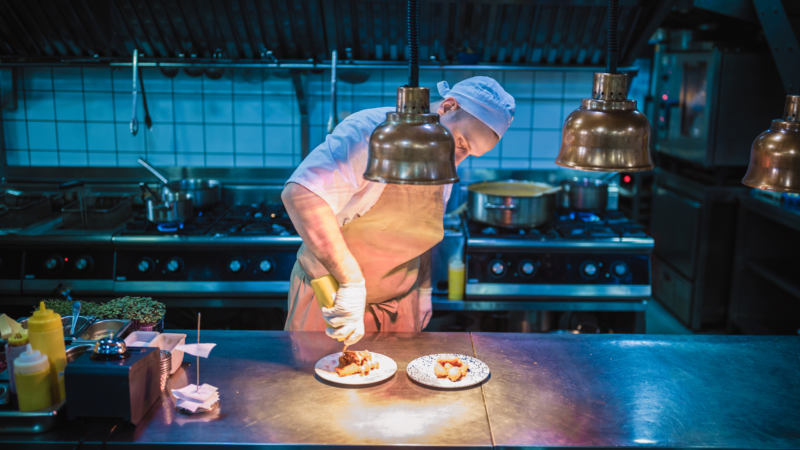
What do you do in the cloud? Storing photos of your latest holiday? Running a cross-team project at work? Streaming entertaining media at the end of a long day? All these answers are correct. There’s one more thing you may be doing in the cloud: ordering food. Here’s a brief overview of how cloud kitchens help bring foodtech further and create an on-demand F&B revolution in the industry.
What is a cloud kitchen?

Everybody knows what a commercial kitchen is. A cloud kitchen acts as a virtual alternative to the restaurant. While food delivery is nothing new, the delivery-only model brings another layer, creating a ghost kitchen that can even cook on behalf of an online-only restaurant.
Does it mean that cloud kitchens have no brick-and-mortar premises to call their own? Not necessarily. The pandemic has been a game-changer for many restaurants. Indeed, they have been encouraged to move their activities online to survive, offering on-demand online delivery rather than in premises. Forced to shut down to physical customers, restaurants still used their existing kitchens to maintain revenues.
It is worth mentioning that cloud kitchens are not a novelty, as they were originally introduced by many entrepreneurs, including Travis Kalanick. Yet, COVID-19 has been a catalyst to drive dark kitchen operations for online-only restaurants, which can save significant costs from startup to upscaling.
How the cloud kitchens are changing the F&B industry
By eliminating the dining area, the ghost kitchen brings a wind of renewal to the restaurant sector. Perhaps, the biggest change is the costs of creating a restaurant’s brand. Established, traditional restaurateurs face high costs to set up a branded dine-in presence. On the other hand, the cloud kitchen model removes the physical facilities, without affecting the branding. It makes building a brand more affordable using existing marketplaces.
Additionally, consumers also praise cloud kitchens for their convenience, making it easy to enjoy a restaurant-quality meal without leaving your home. Customers can use a service such as Uber Eats to order from a local on-demand online delivery restaurant without missing their favorite TV shows.
Cloud Kitchens’ multi-models
In the past years, we have noticed many different models of cloud kitchens seeing the light. Even though new concepts are introduced very often, we highlighted three of them:
- The Brand-Owned Cloud Kitchen: the one where you create your own kitchen for your own brand. The kitchen’s location will determine the delivery radius, usually close to crowded neighborhoods. It is not a novelty, as many Asian and pizza takeaway kitchens have been operating like this for several decades.
- The Real-Estate Cloud Kitchen: the one where you build the real estate but rent the space to third parties. This ghost kitchen consists of having multiple brands using the same facility. For instance, the platform Kitopi Kitchen in Dubai provides end-to-end operations on behalf of restaurants, using shared kitchens in every city they operate in to prepare the food. This model is also referred to as an aggregator cloud kitchen or a coworking cloud kitchen.
- The Hybrid Cloud Kitchen: the one that is a combination of the above two. In this model, you create your own cloud kitchen brand and facility, but also rent a percentage of it to third parties to share the space. With this model, since you own the cloud kitchen you control the margins.
Foodtech pioneering growth
a sector with unlimited potential
Businesses can also expand their operations by combining multiple cloud kitchen models simultaneously. For example, a Chinese takeaway restaurant in NYC owns a brand-owned cloud kitchen with food preparation facilities in one specific location. But it can reach out to a broader audience with rented ghost kitchens in surrounding areas and cities. Unlike a physical setting, this model allows for additional scalability, such as multiplying kitchen rentals to cover more demands and reach out to new delivery locations.
For ambitious entrepreneurs, there can be a lot of growth potential with ghost kitchen rentals to third parties. Indeed, aggregator-managed models run by major players, such as Kitchen United and Rebel Foods, are growing in popularity. Basically, cloud kitchen adoption is expected to grow by more than $1 billion by 2024 according to FoodServiceEquipmentJournal.com. Shared kitchens drive the trend, offering again better scalability and returns for entrepreneurs.
Besides, for restaurants, it’s the first time businesses gain digital data insight into users’ preferences in real-time, creating an adaptable model to grow customer satisfaction.
Tech excellence behind the on-demand online delivery service

At the heart of a virtual kitchen model, the F&B industry must partner with tech specialists that understand this industry and that can deliver a solution to optimize their operations online. At eddress, we are a white-labeled B2B SaaS provider supporting businesses with a customizable, decentralized, and automated end-to-end platform that is adaptable to marketplaces in a variety of industry sectors. Therefore, we are experienced in delivering a branded online platform that integrates with existing tools — including ERP —, and strong fleet management for fast delivery. We also support virtual-only kitchens by providing real-time reporting, full inventory tracking, and other services to manage virtual operations.
If you wish to find out how eddress can help you launch your cloud kitchen, get in touch with our team of experts.







